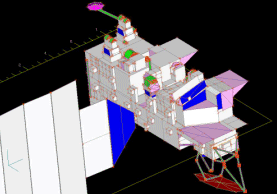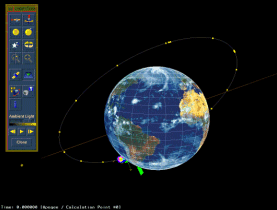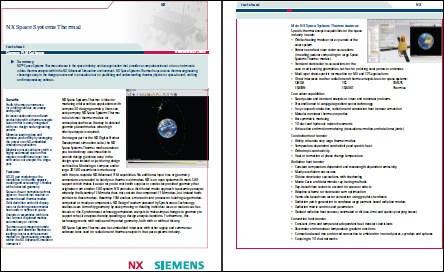
NX Space Thermal
for ![]() Advanced Simulation environment is an industry-specific vertical application
for thermal analysis of space systems.
Advanced Simulation environment is an industry-specific vertical application
for thermal analysis of space systems.


Aplicaciones de NX Space Thermal
![]() Specific
capabilities for the Space industry
Specific
capabilities for the Space industry
-
Orbital models for all planets of our solar system at any specific point in time and attitude
-
Powerful and fast view factor calculations (including parallel computing for large space thermal models)
-
Powerful and smart view factor transient re-calculations for the case of articulation simulations, such as for solar panel joints rotation allowing constant pointing at the sun or antenna pointing to specific location
-
Efficient transient solution for thermal shock transient analyses during eclipse
-
Multi-layer shells specific formulation for MLI and TPS applications
-
Interfaces to:
- SINDA
- TSS
- TRASYS
- ESTAN
- ESARAD
- Thermica
![]() NX
Space Systems Thermal solver capabilities
NX
Space Systems Thermal solver capabilities
-
Steady-state (linear and nonlinear)
-
Large selection of 1D/2D/3D linear and parabolic finite element types supported
-
Material nonlinear thermal properties
-
Multi-layer shells for MLI and TPS applications
-
Axi-symmetric modeling
-
Cyclic thermal problems
-
Iterative conjugate gradient solver technology
-
Fully coupled conduction, radiation and convection heat transfer simulation
-
1D duct and hydraulic network elements
-
Motion and articulation modeling (translational motion and rotational joints)
![]() Thermal
Coupling technology for modeling thermal contacts within NX assembly
Thermal
Coupling technology for modeling thermal contacts within NX assembly
-
Thermally connect disjoint and dissimilar mesh faces and edges
-
Surface-to-surface, edge-to-edge or edge-to-surface contact modeling between parts: constant, time or temperature-dependent coefficient of heat transfer, resistance or conductance
-
Radiative exchange between disjoint part faces, and faces within a single part
-
Interface modeling between connected parts: constant, time or temperature-dependent coefficient of heat transfer, resistance or conductance
-
Convective exchange correlations between faces: parallel plates, concentric spheres or cylinders
-
Join
-
One Way heat transfer
-
User defined
-
Connection break, Series or T-junction
![]() Optical,
material and surface properties
Optical,
material and surface properties
-
Electrical resistivity
-
Phase change and ablation properties
-
Extinction coefficient
-
Refraction
-
Bi-variate tables
-
Transmissivity/specularity
-
Angle-dependent optical properties
![]() Applied
heat loads
Applied
heat loads
-
Constant and time-dependent:
- Heat loads
- Heat flux
- Heat generation -
All applied loads can be controlled with temperature-controlled thermostat conditions or PID controllers
-
Radiative heating
-
Peltier coolers modeling
-
Electrical joule heating
![]() Temperature
boundary conditions
Temperature
boundary conditions
-
Constant temperature for steady-state or transient
-
Time varying for transient and for nonlinear steady-state
-
Thermostat temperature controls or PID controllers
![]() Conduction
heat transfer
Conduction
heat transfer
-
Handles large conduction models (memory efficient data scheme)
-
Temperature-dependent conductivity, specific heat
-
Orthotropic conductivity
-
Heat of formation at phase change temperature
![]() Convection
heat transfer
Convection
heat transfer
-
Constant, time and temperature-dependent heat transfer coefficients
-
Parameter and nonlinear temperature gradient functions
![]() Free
convection
Free
convection
-
Correlation-based free convection to ambient for inclined plates, cylinders and spheres
![]() Forced
convection
Forced
convection
-
Correlation-based convection for plates, spheres and cylinders in forced fluid flow
![]() Radiation
heat transfer
Radiation
heat transfer
-
Constant and temperature-dependent emissivity
-
Multiple radiation enclosures
-
Diffuse view (form) factor calculations with shadowing
-
Net view (form) factor calculations
-
Adaptive scheme for view (form) factor sum optimization
-
Hemicube-based view (form) factors calculation using graphics card hardware
-
Radiation patch generation to condense large element-based radiation models
-
Radiation matrix controls and parameters
-
Additional radiation request types:
- Among group
- Group-to-group
- Monte Carlo calculation method
- Enhanced radiation with Ray Tracing
![]() Initial
conditions
Initial
conditions
-
Starting temperatures for both steady-state and transient
-
Starting temperatures from previous solution results, from file
![]() Solver
solution attributes
Solver
solution attributes
-
Restart conditions
-
Cyclic convergence criteria
-
Direct access to solver parameters
-
Solver convergence criteria and relaxation factors
-
Solver monitor with solution convergence and attributes
-
Intermediate results display and recovery directly from solver progress monitor
-
Open Architecture (user subroutines)
-
Support to include external files
![]() Other
features
Other
features
-
Results Reporter
-
Summary of results to MS® Excel worksheets
-
Heat flow calculation between groups
-
Heat maps
-
Complete or partial deactivation of selected elements (for radiation form factors calculations)
-
Temperature mapping for Nastran FE models
![]() Results
post-processing
Results
post-processing
-
Temperatures
-
Temperature gradient
-
Total load and flux
-
Conductive flux
-
Convective flux
-
Convection coefficients
-
Residual
-
Heat map
-
View factor sum
